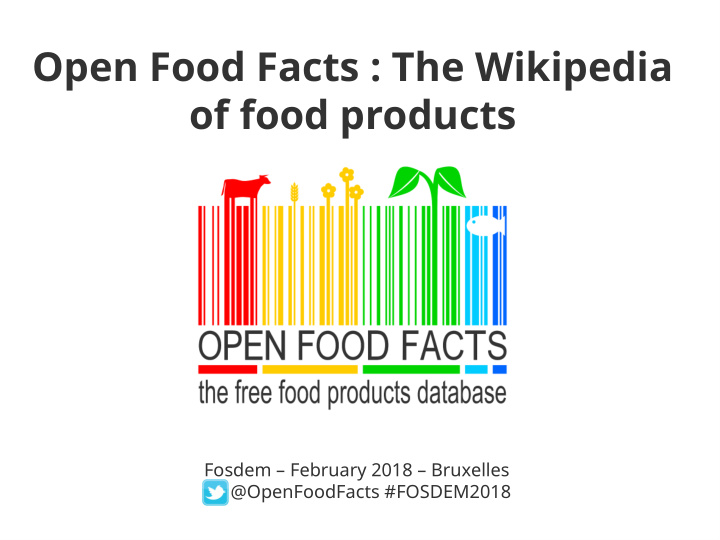



Open Food Facts : The Wikipedia of food products Fosdem – February 2018 – Bruxelles @OpenFoodFacts #FOSDEM2018
Hi, I’m Anca! ● Web Developer , working in Open Source since 2007 (for XWiki) ● Got involved in the Open Food Facts project at the beginning of 2015 ● Ping me on twitter @lucaa
Too much data to digest
Too much data to digest x 43
Crowdsourced, citizen project and ?
Open Data about food
How does it work ? ● Scan bar codes of products with your phone ● Take photos of the labels to add the product or enrich it ● Check out the product information if the product already exists
From images to Open Data On the website: ● Fill in the product page from the information in the photos (assisted by OCR) ● The photo is source and proof of data ! ● Photos are CC-share alike, data is ODbL
All this data, what for? ● Data « standardization » can help better understand a product : additives, allergens, NutriScore, products in foreign languages, etc. ● Comparison ● Exploration of the database of products by various criteria such as : categories, ingredients, additives, etc.
Uuu, stats! 4000+ yogurts
Double uuu, graphs!
Open Data: Reuse in applications Interactive nutrition game: http://howmuchsugar.in Mobile app to fght against food waste « Personal assistant »-like mobile app for food recommendations and evaluation of products VeryDiab, mobile app log-book for diabetes Connected kitchen scale, providing nutritional information upon scan And many more !
Open Data: Citizen science ● Open Food Facts data used for research studies and newspaper investigations. Collaboration with Prof. Hercberg (France's National Program for Nutrition and Health) and the UK Food Standards Agency
Open Data: building for the future ● The amount of information available today is limited – depends on the producer, « limited » accuracy ● Future laws could impose presence of additional information – traceability, recycling, etc. ● Open Food Facts is the place for all this future, interesting data !
Numbers or it didn’t happen! Launched in May 2012 4 200 contributors ● ● Started in France, made for 420 000 products from 181 ● ● the world: 12 languages countries
Open Beauty Facts ● The wikipedia of cosmetic products ● Same functioning as OFF, additional challenges: – ingredients are latin formulae, easier to make mistakes ● 5481 products from 79 countries, added by 197 contributors
OMG, Anca, all this is so awesome, How do I get in?
How to contribute: data Easiest way: ● Download the application ● Scan and take photos ● Fill in the data from photos on the product pages ● Done, welcome to the revolution!
How to contribute: community ● Kick-start the Open Food Facts revolution in your country – talk around you, make presentations ● ressources are available on the wiki of the project – add the initial batch of products that makes it interesting for others to use – translate the software in your language ● Food and cosmetics geeks are welcome!
How to contribute: development Technologies: ● MongoDB database ● Backend: Perl on an Apache server ● Frontend: HTML5, Foundation, jquery ● Mobile application(s): Cordova / PhoneGap, native Android & iOS development, (also Ubuntu Phone, Firefox OS) Topics: ● Contributions from mobile applications ● OpenBeautyFacts polishing ● Machine learning & Big data ● API (re)defnition / (re)implementation ● Anything (else) you want ! Google Summer of Code 2018 Links : Mentoring Organization Candidate ● https://github.com/openfoodfacts/
How to contribute: reuse Rights ● Open Database Licence (ODbL) for the database ● CC-Share Alike for images ● AGPL for the Product Opener server software Means ● Export of data as CSV or RDF ● REST API for accessing data as JSON Links ● https://world.openfoodfacts.org/data
Get in touch https://openfoodfacts.org @OpenFoodFacts @OpenBeautyFacts https://openbeautyfacts.org http://slack.openfoodfacts.org/
Thank you!
Our « business » model
Note on « facts » ● Many controversies about food ingredients / additives – « Causing cancer »… or not, depending on which paper we rely on ● Open *** Facts tries to remain « neutral », and present something that is as close as possible to the notion of « facts » – e.g. forbidden in a country, etc. ● Open the data, without interpreting it – The users of data can make their own interpretation
Madenear.me A need of consumers: know the origin of products
5 colors score + Fruit and vegetable, + protein, fber - Energy, simple sugars, - saturated fat, sodium → Nutritional score → Color code Formula elaborated by the team of Prof. Hercberg : http://fr.openfoodfacts.org/score-nutritionnel-experimental-france
Recommend
More recommend